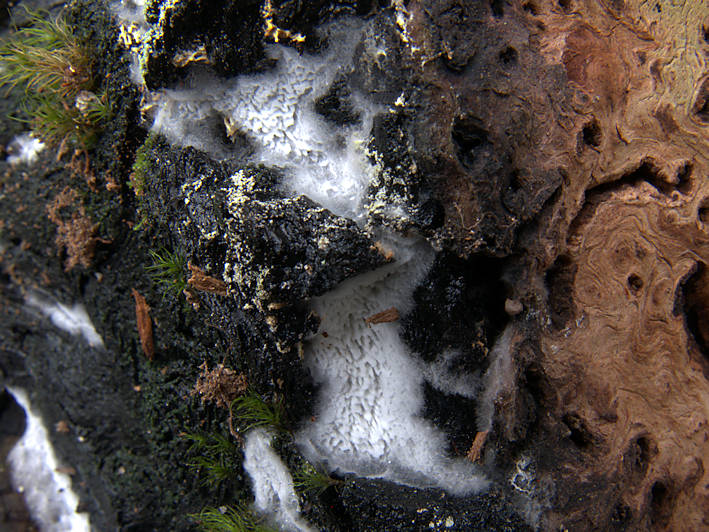
In the “1KFG: Deep Sequencing of Ecologically-relevant
Dikarya” project (CSP1974), we are sequencing keystone
lineages of plant-interacting fungi and saprophytic fungi that are
of special ecological importance for understanding terrestrial
ecosystems. In addition, comparative genome analysis with
saprotrophic, mycorrhizal and pathogenic fungi will provide new
insights into the specific and conserved adaptations associated
with each fungal lifestyle.
Anomoporia kamtschatica OMC
1758
The fungus Anomoporia kamtschatica was described from the
Kamtchatka Peninsula in Northeast Asia, as the name suggests, and
later again from the French Alps under the name A.
ambigua. This polypore species forms white, effused and
fragile fruiting bodies on very rotten conifer wood, usually pines,
and is found throughout the boreal and northern temperate zones of
Eurasia and North America (Niemelä 1994, Rivoire 2020). The
species is associated with brown-rot wood, and may be soil
inhabiting, consuming wood-remnants in the soil. At least in Europe
it prefers old pine forest, is used as an indicator species of high
conservation value (Niemelä 2016) and is found in Red Lists of
several European countries such as Norway and Sweden.
Anomoporia kamtschatica belongs to the order
Amylocorticiales (Binder et al. 2010). This order contains a mix of
white-rot and brown-rot fungi, and offers a good subject in
studying evolution of wood decay modes. The genome will help to
determine wood-decay capabilities of A. kamtschatica, and
contribute to comparative studies on enzymatic basis of wood
decomposition. Furthermore, although the species is related to the
type species of Anomoporia, A.
bombycina, it is not clear if the two should be placed in
one genus. It appears that closest relatives of these
Anomoporia species are corticioid fungi and not other
Anomoporia (Niemelä et al. 2007). Phylogenetic
information provided by the genome will prove helpful in solving
this riddle as well.
The genome strain was collected in Central Finland in Kainuu
region in a rocky pine forest, and is polysporic.
Researchers who wish to publish analyses using data from
unpublished CSP genomes are respectfully required to contact the PI
and JGI to avoid potential conflicts on data use and coordinate
other publications with the CSP master paper(s).
References:
- Binder M, Larsson KH, Matheny PB, Hibbett DS (2010). Amylocorticiales ord. nov. and Jaapiales ord. nov.: Early diverging clades of Agaricomycetidae dominated by corticioid forms. Mycologia 102: 865-880. doi:10.3852/09-288
- Eriksson J, Hjortstam K, Ryvarden L (1981). The Corticiaceae of North Europe 6. Phlebia-Sarcodontia. Fungiflora, Oslo
- Niemelä T (1994). Five species of Anomoporia - rare polypores of old forests. Annales Botanici Fennici 31: 93-115
- Niemelä T (2016). Suomen käävät. Norrlinia 31: 1-430
- Niemelä T, Larsson K-H, Dai Y-C, Larsson E (2007). Anomoloma, a new genus separated from Anomoporia on the basis of decay type and nuclear rDNA sequence data. Mycotaxon 100: 305-317
- Rivoire B (2020). Polypores de France et d'Europe. Mycopolydev, Orliénas
